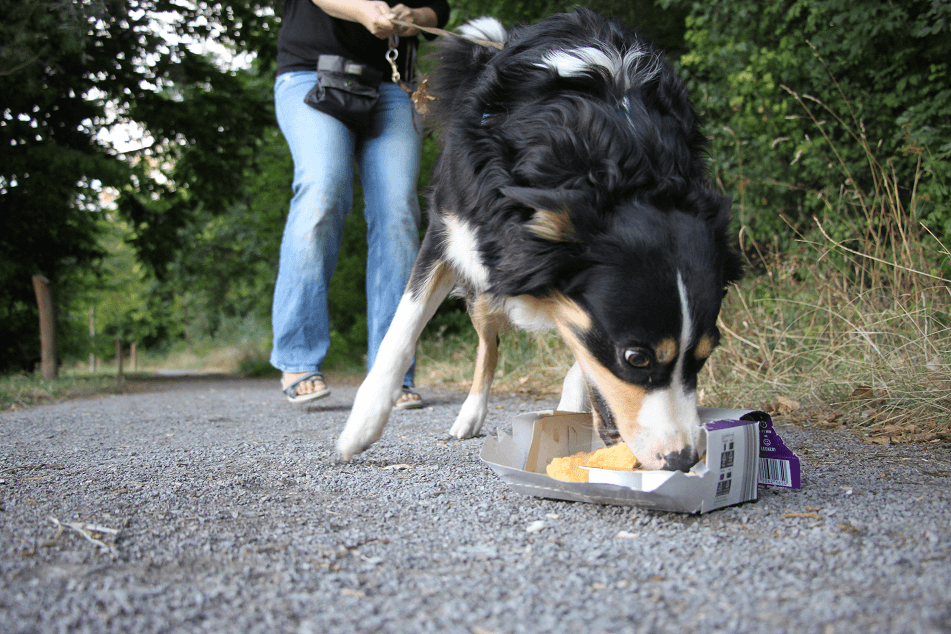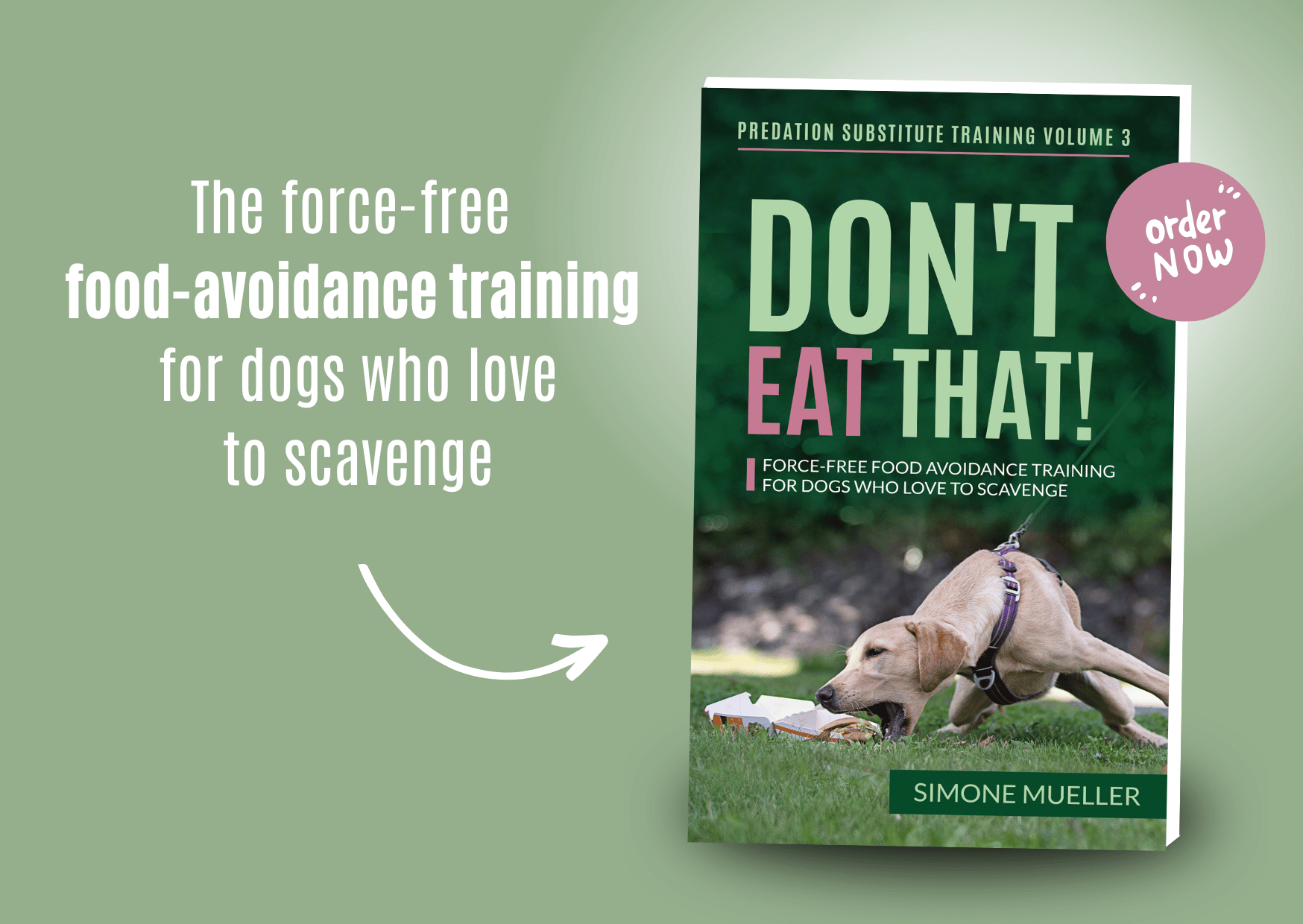‘No, Milo, no! Stop! Don’t eat that!! …. mmm, yummy…!’ 🤢 Well, Milo decided to eat it anyway. While you may be disgusted, Milo seems to be grinning all over his sweet dog face.
He just had another unplanned snack – result! Maybe just a leftover from someone’s picnic? Or a dead mouse? Poop? Or something harmful? Should we get to the vet? And while you are left wondering and feeling stressed out, Milo is not concerned at all. In fact, he is already looking for the next snack coming his way.
Does this sound familiar to you? Then you are not alone at all!
The truth is; most dogs love to scavenge. And most owners don’t know what to do about it. That’s why I wrote my new book ‘Don’t Eat That!’. In it, you will find the answers on what to do and how to train your dog, so that scavenging is no longer their #1 priority.
Just take the test below and see if the book is a perfect fit for you & your dog!

Take The Test:
Will your Dog benefit from ‘Don’t Eat that!’ – Or Not?
The ‘Don’t Eat That!’ training protocol is for anyone whose dog loves to scavenge! Although this is a good starting point, here is some more information to help you to decide if ‘Don’t Eat That!’ is the right route for you and your dog to take:
1. Your dog loves to scavenge
It really is that simple! ‘Don’t Eat That!’ is for ANY dog who loves to scavenge. No matter what breed they are, their age, or their past experiences, this can help! There are no limits on the type of dog that can benefit from working through these training exercises. If your dog seems to make it their life’s mission to scavenge, and you are feeling worn out with trying to stop them, then this training protocol is for you!
2. Your dog BEHAvEs LIKE DOGS naturally do
You may have been told to try and stop your dog’s scavenging behaviour completely. You may have even done some crazy things like hitting food you have found on the floor, to try and show your dog that it’s dangerous (yes, this really happens!) However, the ‘Don’t Eat That!’ training protocol teaches you how to provide your dog with alternative outlets for this natural behaviour instead. Allowing your dog to scavenge in a safe and managed environment is a much better way to get long-lasting results and to help you stay in control.
3. Your dog doesn’t RESPOND WELL TO OTHER TYPES OF TRAINING
Even if your dog is nervous, or unsure and hasn’t responded well to training in the past, then the beauty of ‘Don’t Eat That’ is that you can move at your own dog’s pace. If you already feel like you have tried everything and nothing has worked so far, you absolutely need to give ‘Don’t Eat That!’ a try! There is nothing to rush through and no competition. It’s just you and your dog working through each achievable step, in your own time, without any pressure.
1. Your Dog doesn’t Want To Scavenge
Scavenging is a deep-rooted desire for most dogs, although some love to do it even more than others. And, even if your dog isn’t intensely focused on scavenging, they can still benefit from this protocol! You can find information on how to build a solid ‘drop it’ cue, to help prepare your dog for muzzle training, and to strengthen the bond you share with your dog through ‘Don’t Eat That!’ All these aspects are beneficial to any dog, whether they are scavengers or not!
2. YOur Dog doesn’t enjoy games
The basis of the ‘Don’t Eat That!’ protocol is helping your dog to learn through games. Given the option, dogs would much prefer to learn using positive, upbeat games as a way of teaching, instead of being taught using aversives and force. Not only would your dog prefer these techniques, but you will also get better, longer-lasting results from teaching your dog through play and games. This is much more motivating for them and, therefore, more likely to keep them engaged and interested in learning. Not to mention, it’s a lot more fun for you too!
3. Your Dog shows Scavenging because of a medical condition
It’s possible that your dog is scavenging because of an underlying medical condition or illness. If this is the case, then the ‘Don’t Eat That!’ protocol is unlikely to be helpful for them right now until this is under control. If a dog is in pain, suffering from a medical condition, or taking certain medications, then this can cause their scavenging to increase. So, it’s always best to get your dog checked out by a vet to rule out any underlying issues which could be causing their scavenging.
My book ‘Don’t Eat That!’ is available as ebook and paperback. Just click the button or order your copy on Amazon.
What HUMANS Will benefit from ‘Don’t Eat that!’ – And Which won’t?
In the same way that we advocate for setting our dogs up for success with their training, it’s also crucial that you are set up for success too. Being open and upfront about the work that’s involved in the ‘Don’t Eat That!’ training protocol, will help you start off on the right path to managing your dog’s scavenging successfully. Let’s find out if you are ready for this book:
1. You are Committed
‘Don’t Eat That!’ has fantastic success rates for owners who are committed to helping manage their dog’s scavenging behaviour in a kind, effective way. Although it may take longer than ‘quick fixes’, the results are often better and longer-lasting too! What’s not to like about that?
2. You are frustrated and want to change something
Frustration builds when you think you have tried everything to stop this behaviour, without any good results to show for it. However, this training protocol helps you understand exactly why your dog is scavenging which allows you to help them more successfully!
3. You are often worried about your dogs health
If you are constantly on edge and worried that your dog may become sick from eating scavenged food, then ‘Don’t Eat That!’ is for you! It’s extremely draining if you are always stressed and anxious about what your dog might pick up on their walks, and if it could be dangerous for them. So let me help you feel more positive and confident about managing your dog’s scavenging effectively.
4. You want to train your dog without force
Oh, I’m so glad you nodded at this point! This innovative force-free protocol is ideal for owners who don’t want to use force and intimidation to train their dog. Not only will this achieve better, long-lasting results, but it will also teach you lots more about your dog as an individual. Win-win!
5. You spend a fortune at the vets
If you are tired of spending a fortune at the vets because your dog ate something awful again, then this training protocol can help make this a thing of the past! Save yourself the stress and expense of examinations, procedures, operations and medications that your dog needs to recover from eating something dangerous for them. ‘Don’t Eat That!’ will show you step by step how this is possible.
6. You would love to have a better relationship with your dog
Let’s wrap it up: 1. The protocol is a long-term training plan, this means you will be working closely with your dog every day. 2. The training is based on different games meaning you will have a lot of fun together. 3. This will naturally strengthen the bond you share with your dog and help you achieve much better results! And 4. You will learn a lot about your dog and yourself throughout the process.
So if you are looking for ways to improve your relationship, ‘Don’t Eat That!’ is perfect for you!
1. You want a quick fix
This training is by no means a ‘quick fix,’ it is a long-term training protocol that requires dedication and commitment. Although it may take a little longer, it won’t damage the bond you share with your dog, which other fast solutions are likely to do.
2. You want to have total control over your dog
If you want to stop your dog’s scavenging completely, this is not a sustainable solution! Because scavenging is a perfectly natural behaviour for dogs, it’s unrealistic to eliminate it from their life entirely. This protocol encourages the use of alternative scavenging outlets through games and training instead, which is much more sustainable for everyone involved!
3. You like to use forceful training methods
If you want to use aversive or forceful training methods, then you will not find this in ‘Don’t Eat That!’. Those types of methods may get short-term results, but they are not sustainable and are extremely damaging to your dog’s well-being and mental health, and the relationship you share.
4. You shy away from work
If you are not dedicated to your training and shy away from hard work, then this training protocol is not for you! Although it does achieve fantastic results, it’s not without commitment on your part. This is a long-term training plan, which does take longer than more traditional methods. However, once you get started, it will soon become a normal part of your daily life and you will wonder what you were worrying about!
5. You don’t care about your dog’s feelings
If you are happy to try and control your dog’s scavenging by doing ‘whatever it takes’, then this training isn’t for you! Instead of focusing solely on the behaviour you want to manage, this protocol encourages you to look at the bigger picture. This supports your dog’s emotions, feelings and wellbeing while still getting the results you desire.
6. You are unwilling to learn or change
If your mind is not open to learning and change, then this protocol is not for you! It may require you to change your way of thinking, your daily routine, and how much you train your dog, for you to see the best results. So, if you are not prepared to do this, you will struggle to get the most out of ‘Don’t Eat That!’
Your Result:
Do you have more 👍 or 🚫 answers? If your answers were mostly a thumbs up, then you are most likely to benefit a lot from the ‘Don’t Eat That!’ training approach.
Hopefully, the information in the test above should help you to make an informed decision about whether the ‘Don’t Eat That!’ training protocol is the right fit for you and your dog. Although it has been proven to create fantastic results, this is only possible if you are dedicated and committed to helping your dog to achieve them!
Simone Mueller – Predation Substitute Expert & Founder of Predation Substitute Training


i recently purchased yout Don’t Eat That book. is the training plan pdf log still available anywhere?
Hey Debbie! The link should be in the beginning and in the very end of the book. If you can’t find it, please write me an email to simone@predation-substitute-training.com and I’ll send it to you.
I purchased your book and I’m trying to find out where to download the training log?
Thank you
Hey Susan! The link should be in the beginning and in the very end of the book. If you can’t find it, please write me an email to simone@predation-substitute-training.com and I’ll send it to you.